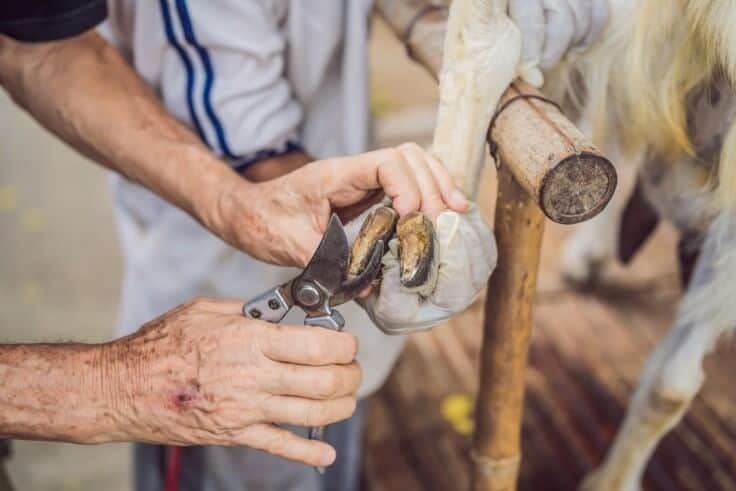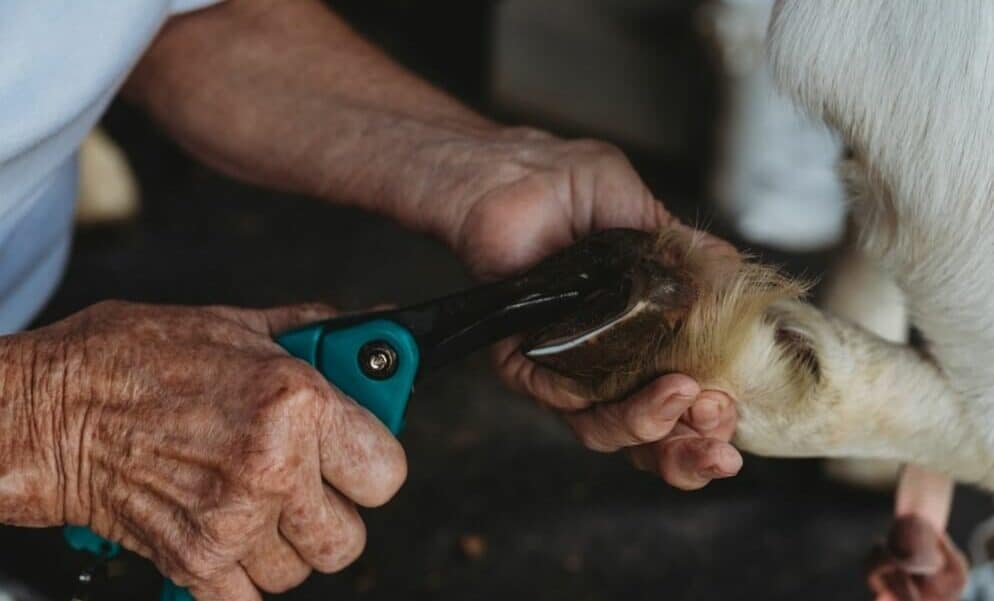There are a lot of skills that go into raising healthy goats. Learning how to trim goat hooves happens to be one of those necessary skills. Goat hooves are made of keratin, just like human fingernails. They continue to grow and need regular maintenance.
You should inspect and maintain goat hooves regularly, approximately every 4 – 6 weeks. However, the time between trimmings depends on the breed, goat age, and types of surfaces the goat walks on. Goats on pasture will likely need less maintenance than goats kept in smaller pens.
Below are the necessary steps and reasons you need to learn how to trim goat hooves. It’s very likely that when you thought about raising goats for milk, meat, or even as pets, you didn’t think that hoof trimming would one day be on your to-do list. However, it is an incredibly important skill for goat owners to master or find a good contact to trim your goats feet.
How to Trim Goat Hooves
Even though there are other forms of goat foot care, frequent trimming of overgrown hooves is one of the best ways to ensure that your goats are free of conditions such as:
- Lameness
- Smelly hooves
- Soft hooves
- Hoof rot
One of the first lines of defense is frequently checking the animal’s feet. As soon as you notice any overgrown hooves, you should trim them. There are goat hoof trimmers and hoof shears available which will be helpful for the job.
Here are some simple steps you can follow to effectively ensure your goats have healthy hooves.
Step 1: Gather the Tools
As is the case with any job, you must gather all the necessary tools before getting started. When it comes to trimming goat hooves, you only need a few tools. You will want a clippers or shear to trim the feet, a hard brush or pick to clean the feet, and a few other things to help the process. Here are some of the tools you’ll need:
- A hoof pick or a hard brush
- Hoof clippers or goat hoof trimmers
- Hoof knife
- A file
- Warm water to soften the feet
- An extra set of hands (a friend) to hold the goat in place
Even though clippers get the job done, they tend to be tedious and rough. A good alternative are sharp shears, secateurs, or pruning shears. These are the same kind of shears you would find in the gardening section. If you are experienced and confident in your abilities, you could even use a handheld electric angle grinder.
Step 2: Bring the Goat to Where You Will Trim
This is often easier said than done. If you have your goats in an enclosure, then it’s very simple. However, you might need a minute or two to catch the goat in question if they are out to pasture. If you have help, you might even be able to trim their feet right where you catch them.
One of the best approaches is luring them with grain or roughage. You could wait for them at the feeding stations or watering holes.
Note: Trimming goat hooves in the morning while the goats are still in the barn may make things easier. Also, planning to trim their hooves after it rains can be helpful. You will often find that the hooves are slightly softer and much easier to cut.
Step 3: Hold the Goat in Place
As you will be using sharp tools, it’s important to have the goat secured and restrained in place before introducing the shears. There are several ways to go about this, but the two most effective include:
- Tethering the goat to a handling area or goat stanchion
- Having a friend or farm hand hold the goat in place
If you are going to have a friend hold the goat in place, make sure they are aware of the horns and have a good hold. You don’t want to loose the goat in the middle of a trim and have to catch them a second time. It’s often easier if the goats are friendly and used to human interaction. They won’t be too skittish when you start working on each hoof.
Step 4: Assess the Goat Hoof and Clean the Hooves
Before you get trimming, you need to take a good look at the goat’s hoof. Pick up one hoof at a time and asses where you should start. You can start with any hoof, but if one needs to soak, you might want to let that one soak while you work on another. Often, you will notice that some hooves need more attention than others.
Gently grab hold of a leg below the knee and bend it towards your line of sight. There may be a hard dirt layer. Once you have a good idea of how bad the situation is, use a brush or hoof pick to clean off any dirt or debris on the hoof’s surface. This will make the hoof fully exposed and helps you locate where to trim.
You might find it hard to get through the layer of dirt in the hoof, this is when it could be helpful to soak the hoof in warm water. This will help to loosen the dirt as well as soften the hoof to make it easier to trim.
Once that is done, take a pick or a hoof knife and use it to pry the hoof walls apart to see what’s going on underneath the surface. This also makes the hoof walls much easier to trim.
Step 5: Trim the Toes
Some goat breeds tend to have excessive toes. Mountain-dwelling goats, such as Alpine goats, Saanen, and Boer goats, are particularly prone to growing excess toes.
You can use your clippers/shears to cut off any long toe pieces you find. Similar to how you would cut your own nails or a dogs nails. However, if there aren’t any long pieces, simply use your hoof knife to scrape at them or cut off the little you find.
Starting with the toes can make less work once you start trimming the walls. This way, you will be better able to work on the walls without the excess toe in the way.
Step 6: Trim the Walls
The should be the next step in the hoof trimming process. Trimming the walls can be the hardest to master, especially on goats with smaller hooves. This is mostly because this part of the hoof is pliable and tends to fold over and cover the bottom of the hoof. After you trim these, you will have a better idea of what’s happening underneath. The hoof wall, along with the toe is what tends to be overgrown on goats.
Use your shears to trim one side of each hoof wall at a time. The goal is to trim the hoof to a more comfortable length for the goat. You will want them to be as level as you can get them. Though, goats will slowly level their own feet after walking on them for some time. Much like how you wear down the bottom of your shoes after wearing them.
Step 7: Scrape the Walls and Soles
Once you are done trimming the walls, it’s time to bring out the hoof knife. Use this to scrape away at any remaining bits of hoof wall that the clippers couldn’t get at. You can also use the hoof knife to scrape away the sole of the hoof.
You should also trim each of the hooves so they are level and flat on the bottom. When doing so, keep a keen eye on the progress. The idea is to get a clean, white, and light pinkish result. If you go any deeper than this, you might cause bleeding. If you do cause bleeding, or feel like you are close, keep a close eye on the goat for an infection or abscess.
Step 8: File to Finish
Once the clippers have done all the heavy lifting, it’s time to put a fine finish on things. Take the time to assess the goat hooves again to ensure you have done a satisfactory job.
Check the walls, the toes, and the sole for any lingering keratin that needs to be cut. Finally, use a file to put a fine finish to the entire process. The idea is to have a well-trimmed and filed-down hoof on every foot.

Why Is Goat Hoof Care Important?
Even though it might seem unnecessary, goat hoof care is essential to raising healthy goats. There are several reasons why you need to tame hoof growth in goats as well as in sheep:
Walking Difficulty
Overgrown hooves make it difficult for your goat to walk. In many cases, these hooves will be overgrown unevenly, which causes both balance and gait issues in goats.
Risk of Disease
Overgrown hooves put the goat at risk of diseases such as foot rot which can cause lameness in a goat. Even worse, foot rot is contagious once it gets going and can affect even the goats in the herd that don’t have overgrown hooves. These factors can make some goats more susceptible to foot rot than others:
- Genetics – Goat foot shape and foot structure
- Environmental conditions – Foot rot is prevalent in consistently moist, wet areas
- Nutrition
- Goat age – Younger goats are more susceptible to foot rot than older goats.
Foot scald is also a concern with goats. Whether you find signs of foot rot or foot scald, you will want to take immediate action. Contact your local veterinarian if you have concerns.
Weight Loss
The animal with an overgrown hoof will find it painful to walk, and, as such, it will be difficult to compete for feed. Whether raising it for milk or meat, not eating will cause the goat to lose weight. This will directly affect the rate at which the goat can reach market weight for meat goats and milk production for dairy goats such as Nubian goats.
Other than weight loss and reduced goat milk production due to lack of eating, dairy goats will find it painful to stand on the milk stand, which will make milking them an absolute chore.
Negatively Affect Breeding
Bucks tend to use their hind legs when mounting does. This will become increasingly difficult to do if their hooves are overgrown. An animal with an overgrown goat hoof will feel discouraged and uninterested in moving, let alone mating.
Finally, goats that experience overgrown hooves might also experience other types of infections or health issues such as arthritis or problems with their tendons and joints. This will eventually negatively affect their health, socialization, and productivity.
As you can see, there’s more to overgrown goat hoof care than just simple vanity. Proper hoof trimming directly ties into the animal’s overall health.

Tips for Trimming Goat Hooves
With regular trimming, any one of your goats will have a healthy hoof free of injury and disease. This process might be slightly tedious, especially if you have many goats on your farm, but it’s worth the effort. You will find that, though tedious, regular maintenance will prevent issues that will take more time and money to fix.
If you find that the goat’s hooves are tougher than you would like, you can make them go through a foot bath several times before trimming the hooves. This will make the keratin softer and give you a much easier time trimming.
The good news is, keeping up with goat hoof maintenance makes it easier to do. This will prevent overgrown goat hooves.

